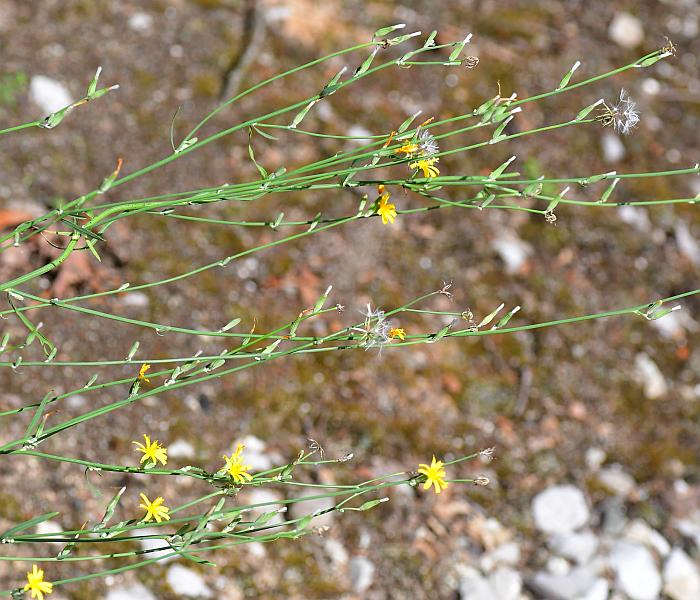Chondrilla juncea L.
Rush Skeletonweed

Introduced
CC = *
CW =
MOC = 0
© SRTurner
Chondrilla juncea L.Rush Skeletonweed | |
 |
Introduced CC = * CW = MOC = 0 |
© SRTurner |
|
Family - Asteraceae/Cichorieae Habit - Taprooted biennial or perennial forb with milky sap. Stems - Spreading to erect, to 1.5 m, rushlike, usually branched, sparsely leafy, bristly-hairy near the base, glabrous upward.
Leaves - Alternate, simple, sessile or short-petiolate. Basal leaves to 12 cm long, oblanceolate, the margins runcinate, withered by flowering time. Stem leaves few, reduced, 2-20 cm long, 1-8 mm broad, linear or narrowly elliptic, glabrous.
Inflorescences - Flowers solitary or in small clusters in branch axils.
Heads - Ligulate. Involucres cylindrical, 9-12 mm long. Involucral bracts in two series, the outer short and crownlike, the inner with 7-9 linear bracts, these 9-12 mm long, glabrous to sparsely tomentose. Heads with 9-12 florets.
Florets - Ligulate, perfect, the corollas bright yellow, with a pappus of soft bristles.
Fruits - Achenes 3-4 mm long, with numerous ribs, also with numerous small, scaly projections near the tip, tan, the beak 5-6 mm long and bearing numerous white pappus bristles.
Flowering - July - October. Habitat - Roadsides, rangelands, fields, pastures, open disturbed areas. Origin - Native to Eurasia. Lookalikes - Lygodesmia juncea, also many other members of the Cichorieae tribe. Other info. - This species has not yet been recorded from Missouri. It is included on this website because it is a common weed across portions of the U.S. and is slowly expanding its range, and might be expected to make an appearance in Missouri at some point. The flowering heads of the plant are similar to those of many other related species, but the nearly naked, wiry stems are characteristic. The plant's nearly leafless stems and skeletal aspect somewhat resemble Lygodesmia juncea, but that plant has pinkish florets. Photographs taken in Kalamazoo, Kalamazoo County, MI, 9-16-2014, at the Bliss rest area, Gooding County, ID, 8-21-2019, and near Loda Lake, Newaygo County, MI, 8-29-2020 (SRTurner). |